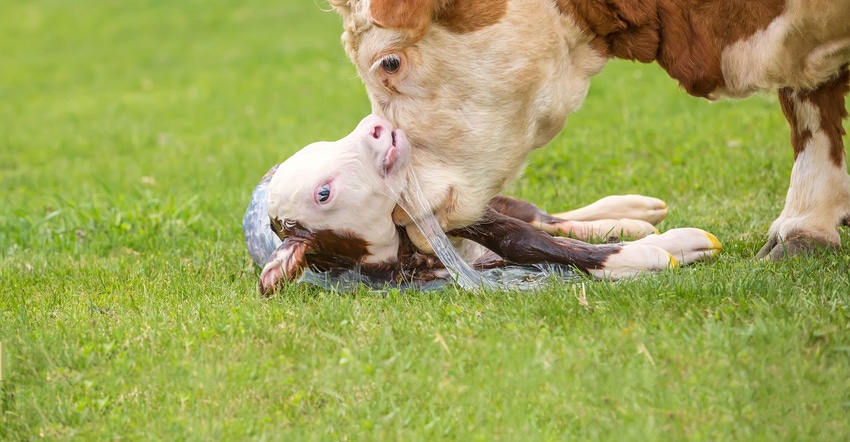March 12, 2020

By Jenna Monnig
The most common cause of calf loss is dystocia, or calving difficulty. Knowing when to intervene and providing timely assistance greatly reduces stress on the calf, dam and producer.
Difficult births also can cause leg fractures, damaged nerves and an increased chance of calfhood diseases. The best way to know when to provide assistance is to know the timeline for a normal birth.
Calving is broken up into three stages.
Stage 1 begins with the dilation of the cervix. This stage usually lasts two to six hours but may last up to 24 hours without worry. There usually are few visible signs during Stage 1, particularly in older cows. Some cows may become restless or isolate themselves from the herd.
By the end of Stage 1, there may be some mucus discharge, and the relaxation of the pelvic muscles may cause either side of the tail head to look "sunken." Complete cervical dilation must be achieved before the cow enters the next stage of parturition and must be checked before any assistance is given.
Stage 2 of calving begins with the calf entering the birth canal and ends with the delivery of the calf. This is the stage where the most intervention may be needed. Stage 2 visibly begins when the water sac can be seen.
Historically, it was thought Stage 2 could last from two to five hours, but recent research shows it is much faster. Studies performed at Oklahoma State University and the USDA research station in Miles City, Mont., found heifers calved unassisted in just less than an hour, while older cows averaged 22 minutes.
Therefore, it is recommended to provide assistance to heifers after 60 minutes with no progress, and to cows after 30 minutes with no progress.
If the cow or heifer is continuing to make progress with each contraction, let her continue on her own. If no progress is being made, perform an examination to determine the size and positioning of the calf and the type of assistance needed. Producers should learn their limits and know when veterinary assistance is needed.
Stage 3 is the delivery of the placenta and fetal membranes. This normally occurs within eight to 12 hours. If the placenta has not been shed after 12 hours, it is considered retained, and a veterinarian should be contacted. The veterinarian can administer antibiotics to guard against infection. The placenta should slough off on its own within four to seven days.
Contact your veterinarian at any stage of calving if a cow is having difficulty. Most veterinarians prefer to be involved early rather than waiting for the problem to become severe. Veterinarians have more experience and tools available, if assistance is needed. It is never too early to get a veterinarian involved.
Monnig is a University of Missouri livestock specialist. She writes from Princeton, Mo.
You May Also Like




